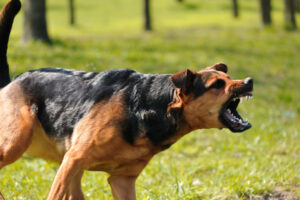As a dog owner, you’ve probably heard dogs growl once or twice, even if they are very timid and calm down normally. But what does it mean when your dog growls? Does this always mean they are about to attack, or are there other potential meanings behind a growl?
Whether you’re an experienced dog owner or this is your first time keeping a dog in your household, it’s important to learn everything you can about their body language and communication. In this article, you’ll find information to help you better understand what your dog might mean when they are growling. Read on to get started.
Irritation
Some dogs are particularly “grumbly” and may growl quietly any time they feel irritated. Dogs who growl frequently out of irritation will typically growl louder if they feel they need to work harder to get their point across to a human or another animal.

If your dog’s growling is accompanied with body language like raised hackles or their ears laid flat back against their head it means they are getting closer to acting out aggressively. They may also have her back arched or hunched, and they may hold their tail straight out behind them, depending on the dog and the situation.
Resource Guarding
Dogs may growl if they feel defensive over a resource or their own personal space. Keep in mind that what a dog considers a resource can be quite variable.
While most of us understand that almost all dogs consider food and their favorite toy to be resources, sometimes we don’t realize that something like water, a favorite resting spot, or their owner may be considered a resource as well. If your dog growls to guard a resource, you may want to work with a veterinary professional to manage this issue before your dog escalates their aggression to a bite.
Fear
Some dogs may growl when they are afraid or anxious about something. This type of growling is often quieter and lower, but can vary from dog to dog. Dogs who have a lot of regular daily anxiety may be more prone to this type of growling than others.
If your dog tends to growl to herself when they look out the window and sees something in their yard, this may be a sign of fear, but could also be due to territoriality. If they hide and growl when hear thunder or fireworks outside, this is a clear example of fear growling.
Territory
Some dogs may growl when they want to defend their territory. Dogs who are very territorial are naturally going to be more likely to growl for this reason than others, but any dog can feel this way about spaces they consider their own.
If your dog growls when someone strange knocks on the front door or when you have visitors they have never met before, these are examples of growling out of territorial behavior (although it could also be due to fear).

Pain
Finally, dogs may growl when they are in pain. This growling may occur at any time when a dog is dealing with pain, but may be more likely if the dog is approached by a human or another animal who they are worried may be exacerbating the pain in some way.
If your dog is growling and seems to be showing other signs of pain, such as favoring a sore leg or licking a specific spot on their body over and over, then you should consider bringing them to the veterinarian.
Summary
It is important to understand that growling is always a sign of aggression. Some dogs may growl more than others, but all dogs growl for a reason, not just doing it because they feel like it. The dog is trying to tell you to stay away or stop doing what you’re doing, but the motivation for the growling can vary widely.
If your dog is growling, it is important to try to understand why. Aggression can escalate to a bite if not addressed. If you’re unsure why your dog is growling it is important to bring them to your veterinarian to get help identifying and treating the issue that is causing them to growl.
